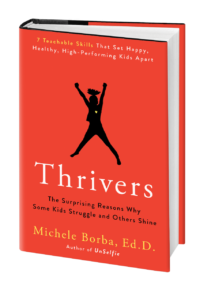Great Kids’ Books That Teach Empathy and Character
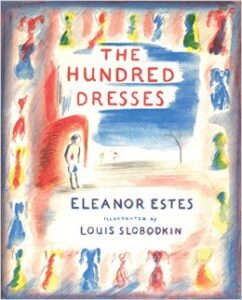 Books can transport children to other worlds and transform their hearts.
Books can transport children to other worlds and transform their hearts.
I learned that lesson as both a teacher and a mother. I’ve seen those wondrous moments when a child’s heart opened and saw the world differently. It’s why The Hundred Dresses by Eleanor Estes is one of my favorite children’s book.
It tells the stirring story of Wanda Petronski, a poor, quiet, third-grade girl who always wears the same faded blue dress. Wanda has no friends and often sits and plays alone. She also must endure a few cruel classmates who constantly taunt her about her one dress. “What are you going to wear tomorrow?” the girls would dig, knowing she has only one dress.
Finally, one day Wanda blurts, “I have a hundred dresses at home-all different colors!” Well, the torment spirals to such a level that Wanda’s parents can no longer endure the cruelty their daughter faces. (Her father’s letter describing her daughter’s pain is priceless!) And the Petronski family moves to a different location. Only later do the “mean” girls realize that Wanda has remarkable artistic talents: she did have a hundred dresses at home-but they were all drawn on paper, and guilt sets in. YES! Those girls finally understand the pain they caused and even empathize. But by then Wanda is gone and the girls can never make amends for their cruel actions.
Over the years I’ve read my now well-worn book to countless classes as well as to my children, and its haunting tale never fails to stir their emotions. I ask, “Have you ever had someone make fun of how you dress or look or made fun of another kid or excluded them because they looked differently?” and hands always rise slowly or the children will look down at their feet.
Danny was no different. He was a third grader and his teacher read to his class The Hundred Dresses. The book touched him and “changed me on the inside. I thought of Ryan,” he told me. “He was lonely and had kids picking on him just like Wanda. That book made me feel differently about Ryan and me. It made me want to do something to help.”
The right book can not only touch a child’s heart but also mobilize empathy into compassion. That’s the miracle of the right words. Reading the right books can make our kids not only smarter, but also kinder!
New research confirms the power of literary fiction (and film) to elevate children’s hearts and activate their empathy. It turns out that reading literature-even for short periods-can enhance empathy, and proof of that is showing up not only on paper-andpencil tests, but also on images of our brains. The more effort we make trying to figure out a character’s intentions, emotions, or thoughts, the greater the odds that our empathy muscles are stretched as well. It’s why I chose “MORAL IMAGINATION” as the fourth Empathy Habit in UnSelfie: Why Empathetic Kids Succeed in Our All About Me World.
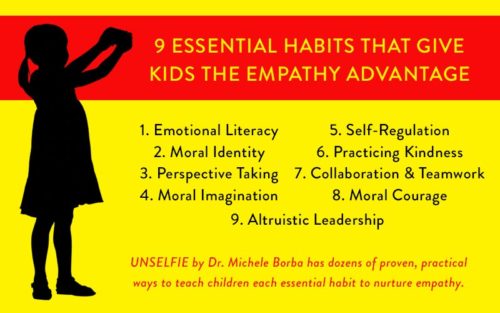
Here are 50 favorite books Ilist in UnSelfie that can help children and teens step into a character’s shoes-emotionally at least-and identity with their discomfort and feel their pain. Part of the secret in activating empathy is offering material that matches the child’s interests as well as reading abilities.Chapter Four-pages 71 to 92-in UnSelfie offers dozens of ways to stretch children’s hearts as they read, as well as questions to ask to boost perspective taking. I also offer ideas to help you find the right book for the right kid. Meanwhile, keep looking until you find the perfect match and let’s keep reading to our children!
Younger Children
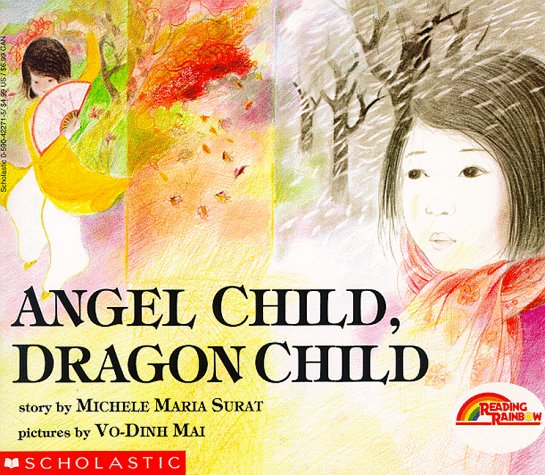
1. Angel Child, Dragon Child, by Michele Maria Surat. A young Vietnamese girl arrives at her new American school and faces taunts by her classmates for her cultural differences.
2. A New Coat for Anna, by Harriet Zeifert. Though there is no money to buy Anna a new coat, her mother’s determination to save money for many months produces a beautiful gift.
3. A Special Trade by Sally Wittman. When she was young, the little girl’s grandfather pushed her in the stroller. Now five, Grandfather has a stroke: the girl pushes Grandfather as he once pushed her. Plain glorious for kids.
4. Fat, Fat Rose Marie, by Lisa Passen. A little girl must stand up to the class bully who keeps picking on her overweight friend and treating her most unfairly.
5. Fly Away Home, by Eve Bunting. The plight of a homeless boy and his father is told in this poignant tale. The only home that Andrew and his dad have is an airport, and as Andrew’s dad says, “It’s warm. It’s safe. And the price is right.”
6. Molly’s Pilgrim, by Barbara Cohen. Deals with issues of disrespect, loneliness and prejudice as a young immigrant girl is ridiculed and rejected by her classmates for her cultural differences.
7. Old Henry, by Joan W. Blos. Henry’s neighbors don’t appreciate the way their eccentric resident keeps his yard, so they run him out of the neighborhood then find themselves missing him.
8. Somebody Loves You, Mr. Hatch, by Eileen Spinelli. A year-round Valentine to read to children on the impact they have on others. This book can start a Kindness Challenge.
9. Through Grandpa’s Eyes, by Patricia MacLachlan. A sensitively told tale of a young boy who visits his blind grandfather and learns there is more than just one way of seeing than from using your eyes: young John learns to “see” as his Grandpa does. (Perfect for empathy)
10. The Bedspread, by Sylvia Fair. A gloriously written account of two elderly sisters whose embroidery reflects their diverse personalities. The final product offers two very different views of life with the clear message, “There is no one way that is better.” Great for discussing diversity, tolerance, sensitivity and empathy.
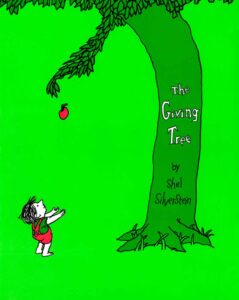 11. The Giving Tree, by Shel Silverstein . An absolute gem that’s become a classic parable about giving and kindness appropriate for just about any age. It’s just that good!
11. The Giving Tree, by Shel Silverstein . An absolute gem that’s become a classic parable about giving and kindness appropriate for just about any age. It’s just that good!
12. Wilfrid Gordon McDonald Partridge, by Mem Fox. A young boy’s learns his friend from the old people’s home is losing her memory! He sets out to help her find it, and in doing so learns the power of caring. A favorite!
For Children Ages 8 to 11
13. Blubber, by Judy Blume. An overweight girl must learn to deal with ridicule and rejection from her classmates.
14. Building Blocks, by Cynthia Voigt. A short but heartwarming tale in which a twelve-year-old boy is transported back in time and wakes up to find himself in the bedroom of a ten-year-old boy, who he discovers is to become his father. He literally “gets into the shoes of his father” and takes on a whole new understanding of his dad’s strengths and weaknesses.
15. Charlotte’s Web, by E.B.White. The problem of a pig named Wilbur who is slated to be butchered because he was the runt of the liter. Charlotte the spider figures out how to save Wilbur’s life without regard for her own life. It is rich in the moral values of fairness, empathy, conscience and compassion.
16. Dear Mr. Henshaw, by Beverly Cleary. A Newbery Award-winner about a boy coming to grips with his family’s divorce. He describes his feelings through a series of letters to an author who becomes a significant other in his life.
17. Number the Stars, by Lois Lowry. Based on the true, compassionate story of a young Danish girl who sacrifices her life to save her friend from the Nazis.
18. Roll of Thunder, Hear My Cry, by Mildred Taylor. A black Mississippi family during the Depression refuses to give in to the unfair threatment and social injustice by white neighbors.
 19. Stone Fox, by John Reynolds Gardnier. Based on a Rocky Mountain legend, Stone Fox tells the story of Little Willy, who lives with his grandfather in Wyoming. When Grandfather falls ill, he is no longer able to work the farm, which is in danger of foreclosure. Little Willy is determined to win the National Dogsled Race—the prize money would save the farm and his grandfather. I still remember reading this to my sons and sobbing.
19. Stone Fox, by John Reynolds Gardnier. Based on a Rocky Mountain legend, Stone Fox tells the story of Little Willy, who lives with his grandfather in Wyoming. When Grandfather falls ill, he is no longer able to work the farm, which is in danger of foreclosure. Little Willy is determined to win the National Dogsled Race—the prize money would save the farm and his grandfather. I still remember reading this to my sons and sobbing.
20. Stone-Faced Boy, by Paula Fox. Ridicule and rejection from classmates cause Gus to “turn off” his emotions and become “stone-faced.”
21. Teammates, by Peter Golenbock. Powerful text describing the racial prejudice and unjust treatment experienced by a black player in major league baseball and the difficulty of getting along as a team.
22. The Bear’s House, by Marilyn Sachs. A moving account of a lonely girl who must deal with a dysfunctional home environment. Powerful for building empathy.
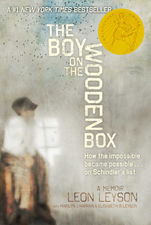 23. The Boy on the Wooden Box, by Leon Leyson. Remarkable memoir written by one of the youngest children to survive the Holocaust on Oskar Schindler’s list perfectly captures the innocence of a small boy who goes through the unthinkable. Leon Leyson was only ten years old when the Nazis invaded Poland and his family was forced to relocate to the Krakow ghetto. Perseverance, grit, optimism. empathy!
23. The Boy on the Wooden Box, by Leon Leyson. Remarkable memoir written by one of the youngest children to survive the Holocaust on Oskar Schindler’s list perfectly captures the innocence of a small boy who goes through the unthinkable. Leon Leyson was only ten years old when the Nazis invaded Poland and his family was forced to relocate to the Krakow ghetto. Perseverance, grit, optimism. empathy!
24. The Hundred Dresses, by Eleanor Estes. An impoverished girl is made fun of by her classmates, who mock her for always wearing the same faded blue dress. A powerful story about that helps sensitize children to the cruelty of emotional abuse.
25. The Invisible Boy, by Trudy Ludwig. (Or anything else by Trudy Ludwig. She’s that good). Meet Brian, the invisible boy. Nobody ever seems to notice him or think to include him in their group, game, or birthday party…until, that is, a new kid comes to class. When Justin, the new boy, arrives, Brian is the first to make him feel welcome. And when Brian and Justin team up to work on a class project together, Brian finds a way to shine.
26. The Little Prince, by Antoine de Saint-Exupery. The Little Prince is on a search as to what is truth and discovers: “It is only with the heart that one sees rightly.” This classic is a moral gem that addresses the virtues of honesty, conscience, responsibility, and empathy.
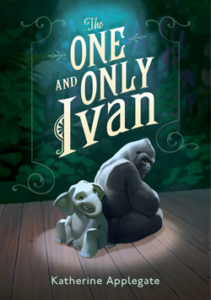 27. The One and Only Ivan, by Katherine Applegate. An unforgettable novel (and winner of the Newbery Medal) that celebrates the transformative power of unexpected friendship. Inspired by the true story of a captive gorilla known as Ivan, this illustrated book is told from the point of view of Ivan himself. Perspective Taking!!
27. The One and Only Ivan, by Katherine Applegate. An unforgettable novel (and winner of the Newbery Medal) that celebrates the transformative power of unexpected friendship. Inspired by the true story of a captive gorilla known as Ivan, this illustrated book is told from the point of view of Ivan himself. Perspective Taking!!
28. The Sneetches, by Dr. Seuss. The classic Seuss story about the Sneetches and the Sneetches each thinking they are the best. It’s a wonderful way to introduce the concept of prejudice to very young children.
29. The Witch of Blackbird Pond, by Elizabeth George Speare. A 16 year old girl in a Puritan community and balks at their narrow-minded. She later befriends a lonely old woman who is unjustly accused of being a witch and eventually Kit is unjustly accused as well.
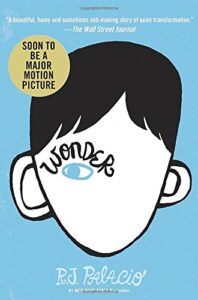 30. Wonder, by R J Palacio. Over six million people have read the #1 New York Times bestseller and fallen in love with Auggie Pullman, an ordinary ten-year-old boy with a facial deformity. A remarkably courageous kid, Auggie comes across as a sweet, funny boy who wants the same things others want: friendship, understanding, and the freedom to be himself. Empathy!!!
30. Wonder, by R J Palacio. Over six million people have read the #1 New York Times bestseller and fallen in love with Auggie Pullman, an ordinary ten-year-old boy with a facial deformity. A remarkably courageous kid, Auggie comes across as a sweet, funny boy who wants the same things others want: friendship, understanding, and the freedom to be himself. Empathy!!!
For Middle School and Teens
Please check content for suitability
31. A Lesson Before Dying, by Ernest J. Gaines. Set in a small Cajun community in the late 1940s, a young black man is unjustly accused of murder and is sentence to death. Enormously moving tale of compassion, unfairness, mercy, and unfairness.
32. Black Like Me, by John Howard Griffin. A true story about a white man in the 1950s who darkens his skin so he can “become” a black man living in the deep South. The racism and unfairness he encounters are just wrenching.
33. Children of the River, by Linda Crew. A thirteen-year-old girl has fled Cambodia with her aunt’s family to escape the Khmer Rouge army, leaving behind her family and the boy she has loved since she was a child. Now, four years later, she struggles to fit in at the high school. Depicts the emotional grief for her lost family and the consequences of war. For advanced readers.
34. Farewell to Manzanar, by Jeanne Wakatsuki Houston and James D. Houston. The touching true story of a Japanese American family who was uprooted from their home and set to live at the Manzanar internment camp because of their Japanese ancestry.
35. Great Expectations, by Charles Dickens. This literature classic is the story of a young orphan boy who mysteriously acquires a great fortune and then tries to discover his benefactor. The crux of the novel is his relationship with two men: his foster father, a simple, kind man and the evil Abel Magwitch, an escaped convict who the boy befriends.
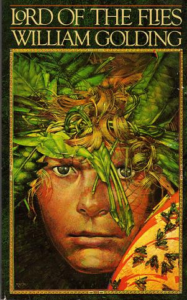 36. Lord of the Flies, by William Golding, A group of English schoolboys become stranded on a desert island during a nuclear war. Gradually throughout the ordeal their character transforms from “civilized” and “proper” into cruel, greedy savages without an ounce of kindness.
36. Lord of the Flies, by William Golding, A group of English schoolboys become stranded on a desert island during a nuclear war. Gradually throughout the ordeal their character transforms from “civilized” and “proper” into cruel, greedy savages without an ounce of kindness.
37. Of Mice and Men, by John Steinbeck. The friendship between two stirring characters: mentally handicapped and warm-hearted Lenny and his protector, George. Heartbreaking moments depicting a world that can sometimes be cruel and selfish make for ripe moral discussions.
38. Manchild in a Promised Land, by Claude Brown . First published in 1965, this is one of the most remarkable autobiographies of our time. It is a thinly fictionalized account of Brown’s childhood as a hardened, streetwise criminal trying to survive the toughest streets of Harlem and makes it. It is affirmative, inspiring and rich with values.
39. Night, by Elie Wiesel. Wiesel tells a wrenching story based on his own experiences in the concentration camp during World War II in which he witnesses the death of his family. It is unforgettable and sends a clear message of how immoral intolerance can be and the impact of a complete lack of empathy.
40. Please Stop Laughing At Me!: One Woman’s Inspirational Story, by Jodie Blanco. An inspirational memories about how one child was shunned and even physically abused by her classmates from elementary to high school. Impossible not to be moved! For young teens.
41. Pride and Prejudice, by Jane Austen. The classic about the prejudice that occurred between the 19th century classes and the pride, which would keep lovers apart. Look carefully at the “supposed arrogance” of a few of the characters: particularly the uncle. What becomes apparent in the ending is that some people put on airs to cover up insecurities or traumatic earlier experiences.
42. Speak, by Laurie Halse Anderson. A tough, tender and funny story of a teenage outcast. It captures the harsh conformity of cliques and a teen’s struggle to find acceptance. Beware: the issue of rape is addressed but her ultimate triumph (and her surprise “rescuers”) will make you cheer.
43. The Color of Water, by James McBride. A moving memoir of a young black boy growing up at a time of racial polarization. The unforgettable character is his compassionate mother who raises her children to see themselves as human beings who have something to give to others.
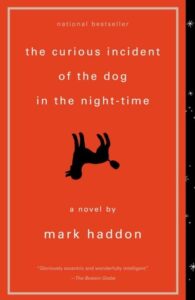 44. The Curious Incident of the Dog in the Night-Time, by Mark Haddon. Christopher John Francis Boone knows all the countries of the world and their capitals and every prime number up to 7,057. He relates well to animals but has no understanding of human emotions. He cannot stand to be touched.
44. The Curious Incident of the Dog in the Night-Time, by Mark Haddon. Christopher John Francis Boone knows all the countries of the world and their capitals and every prime number up to 7,057. He relates well to animals but has no understanding of human emotions. He cannot stand to be touched.
Although gifted with a superbly logical brain, for fifteen-year-old Christopher everyday interactions and admonishments have little meaning. He lives on patterns, rules, and a diagram kept in his pocket. This novel is funny, poignant and fascinating and it helps the read perceive the world of the character.
45. The Diary of Anne Frank, by Anne Frank. Talk about Anne’s indomitable optimistic spirit and ability to find goodness despite horrendous circumstances. It is just plain magnificent an should be read by every child.
46. The Hate Crime, by Phyllis Karas. High-school sophomore, Zack, never thought being Jewish was any big deal until someone painted anti-Semitic graffiti on the Temple Israel.
47. The Invisible Thread, by Y. Uchida. This is a powerful memoir of a Japanese American girl who was held with her family along with 130,000 other Japanese American citizens in U.S. internment camps during World War II.
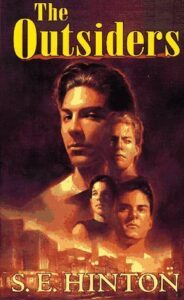 48. The Outsiders, S.E. Hinton.. This remains a favorite of boys and does present great discussion possibilities. It addresses a vicious gang of kids whose idea of good time is beat up the greasers until one night things go too far. There is also a movie version of the book.
48. The Outsiders, S.E. Hinton.. This remains a favorite of boys and does present great discussion possibilities. It addresses a vicious gang of kids whose idea of good time is beat up the greasers until one night things go too far. There is also a movie version of the book.
49. To Kill a Mockingbird, by Harper Lee. A deeply moving novel about prejudice and injustice as seen through the eyes of a little girl, the daughter of a lawyer who defends a black man against an unfair rape charge in a Southern town in the 1930s. The film starring Gregory Peck is also glorious and provides wonderful discussion opportunities about conscience, empathy, tolerance, respect, and unfairness. The movie is also strongly recommended.
50. Warriors Don’t Cry, by Melba Pattillo Beals. The true remarkable story of Melba Pattillo, one of the nine teenagers chosen to intergrate Little Rock’s Central High School and the racism they endured.
Join the #UnSelfie Revolution to Raise Kids with Empathy, Moral Conviction and Courage To Make a Better World
I’ll share proven ways in this article that we can use to cultivate our children’s empathy and switch their attitudes from WE, not ME. The ideas and story from this post are adapted from my latest book, UnSelfie: Why Empathetic Kids Succeed in Our All About Me World which describes how to cultivate the Nine Crucial Habits of Empathy, and offers dozens of proven ways parents and teachers can use from toddlers to teens to do so.
And I’m thrilled to announce the arrival of my new book, Thrivers: The Surprising Reasons Why Some Kids Struggle And Others Shine on March 2 (hardback, digital and audio!) It has been a forty-year journey to write it – my goal has always been to find the science as to why children thrive. I discovered seven strengths that and they are teachable! The book is filled with practical, proven ways to raise mentally and morally strong children who are ready for an uncertain new normal.
Follow me on Twitter @MicheleBorba or on my website MicheleBorba.com for over 500 articles on character, resilience and empathy building as well as how to contact me for speaking.
